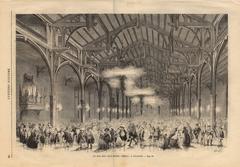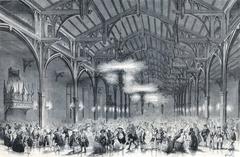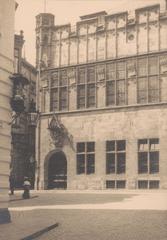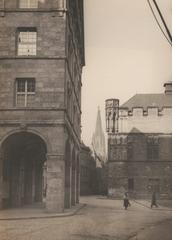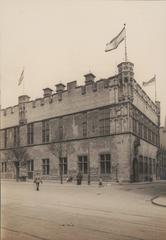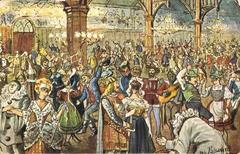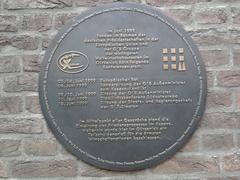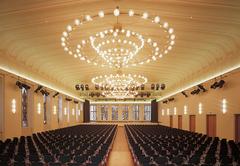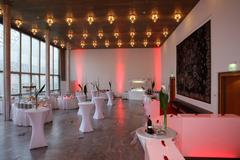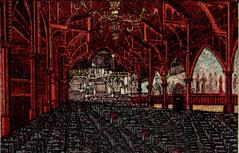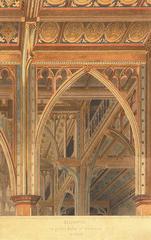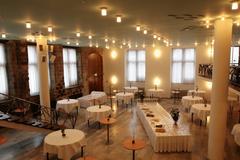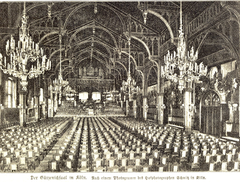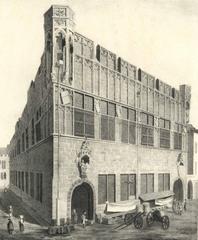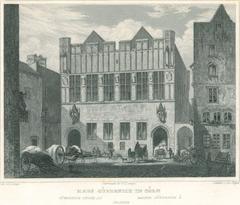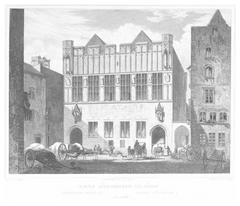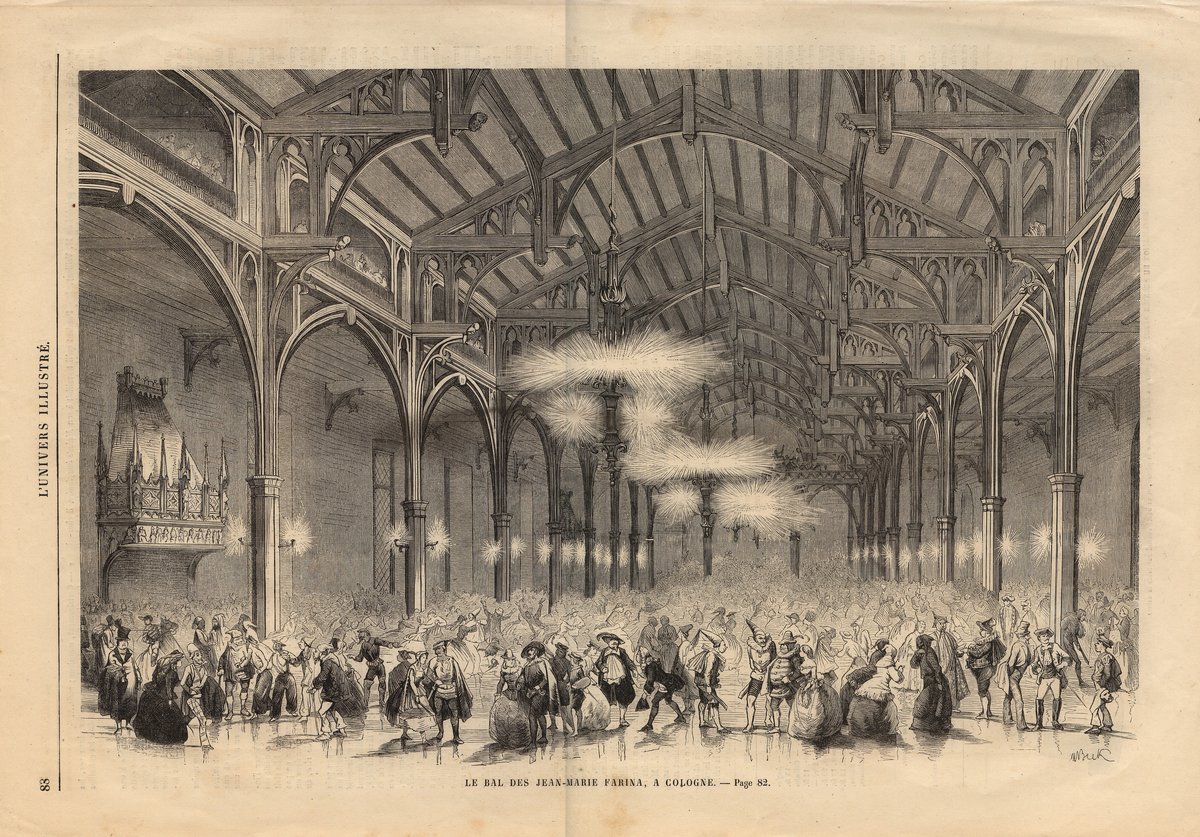
Gürzenich Cologne: Visiting Hours, Tickets, and Historical Significance Guide
Date: 14/06/2025
Introduction to Gürzenich Cologne
Located in the heart of Cologne’s historic Old Town, the Gürzenich stands as a striking symbol of the city’s rich heritage and ongoing cultural vibrancy. Built between 1441 and 1447, this grand Gothic building was originally the largest ballroom in Germany. Over the centuries, it has served as a focal point for Cologne’s social, political, and cultural life—from hosting the Imperial Diet and lavish court festivities to being at the center of Cologne’s world-famous Carnival.
Today, the Gürzenich is a versatile event venue, seamlessly blending its medieval architecture with modern event amenities. Its proximity to landmarks like Cologne Cathedral and Heumarkt makes it a must-see for any visitor interested in Cologne’s history and culture. While public access is generally tied to scheduled events, guided tours are available by appointment and provide in-depth insights into the Gürzenich’s storied past.
This detailed guide covers the Gürzenich’s historical and architectural highlights, practical visitor information—including hours, tickets, and accessibility—plus suggestions for nearby attractions and travel tips to ensure a memorable visit. For the most current information on events and visiting hours, refer to the official Gürzenich event page and the Gürzenich Orchestra website.
Table of Contents
- Introduction
- Medieval Origins and Construction
- Political and Social Significance in the Holy Roman Empire
- Architectural Evolution and Wartime Destruction
- The Gürzenich and Cologne’s Cultural Identity
- Architectural Highlights of the Gürzenich
- Interior Layout and Functional Spaces
- Neo-Gothic Expansion and 19th-Century Modifications
- Post-War Reconstruction and Modernization
- Visiting the Gürzenich: Hours, Tickets, and Tours
- Practical Visitor Information
- Nearby Attractions and Travel Tips
- Frequently Asked Questions (FAQ)
- Visuals and Media
- Conclusion and Call to Action
- References
Medieval Origins and Construction
The Gürzenich’s origins trace back to the 15th century, when Cologne was a flourishing city within the Holy Roman Empire (latlon-guide.com). Built on land from the Gürzenich family, the hall was completed in 1447 and immediately became the largest ballroom in the country. Its Gothic architecture is distinguished by pointed arches, ribbed vaults, and a stately façade, all reflecting the city’s growing prominence and civic pride.
Political and Social Significance in the Holy Roman Empire
From its opening through the early 16th century, the Gürzenich served as Cologne’s premier venue for political and social gatherings. It hosted Imperial Diet meetings, coronation festivities, and receptions for European rulers, earning its nickname as “Die Gute Stube Kölns” (“Cologne’s Good Parlor”) (tonight.de). This central role established the Gürzenich as a place where history was made and celebrated.
Architectural Evolution and Wartime Destruction
While the Gürzenich’s structure remained largely unchanged for centuries, it suffered extensive damage during World War II. Cologne’s historic center was devastated, leaving the Gürzenich in ruins until its reconstruction in the 1950s (latlon-guide.com). The postwar restoration preserved key Gothic features while modernizing facilities, symbolizing Cologne’s resilience and commitment to its heritage (tonight.de).
The Gürzenich and Cologne’s Cultural Identity
Historical and Social Role
Since medieval times, the Gürzenich has been central to Cologne’s social and cultural life (viaculturalis.cologne). Once a merchants’ hall, it later evolved into a venue for balls, concerts, and civic ceremonies, reflecting Cologne’s status as a major trade and cultural hub (discoveryartfair.com).
Venue for Major Cultural Events
The Gürzenich is renowned for hosting a diverse range of events, from art fairs and classical concerts to lavish balls and civic celebrations. Its six event spaces can accommodate over 1,300 guests, making it a cornerstone of Cologne’s cultural calendar (viaculturalis.cologne). The Kunstmarkt Köln, first organized at the Gürzenich in the 1960s, was pivotal in revitalizing the postwar German art market (discoveryartfair.com).
Cologne Carnival and Community Symbolism
The Gürzenich is closely linked with Cologne’s Carnival, the “fifth season,” with festivities commencing each November 11 (latlon-guide.com). During Carnival, the Gürzenich hosts balls, concerts, and celebrations, highlighting its status as a symbol of Cologne’s communal spirit.
Home of the Gürzenich Orchestra
Since the 19th century, the Gürzenich has been home to the Gürzenich Orchestra, one of Germany’s most prestigious ensembles. The orchestra’s performances, frequently held at the Gürzenich and the nearby Philharmonie, reflect the hall’s ongoing commitment to musical excellence.
Urban and Cultural Integration
Located near Cologne’s major landmarks, the Gürzenich is woven into the urban and cultural fabric of the city (keln.net). Its continued use for official functions and cultural events cements its place in Cologne’s community life and heritage.
Architectural Highlights
The Gürzenich exemplifies late Gothic civic architecture (A View On Cities). Its rectangular stone structure is adorned with crenelated walls and corner turrets, while the main façade features pointed-arch entrances and tracery reminiscent of ecclesiastical buildings. Statues of Marcus Vipsanius Agrippa and Marsilius underscore Cologne’s ancient roots.
Tall cross windows illuminate the halls, enhancing the sense of grandeur and verticality characteristic of the Gothic style.
Interior Layout and Functional Spaces
The upper floor houses the expansive Großen Saal (Great Hall)—23 meters wide and 53 meters long—originally designed for grand festivities and receptions (A View On Cities). The ground floor historically functioned as a warehouse and salesroom, showcasing the building’s adaptability.
Neo-Gothic Expansion and 19th-Century Modifications
In 1867, a neo-Gothic annex was added by Julius Carl Raschdorff, including a 200-square-meter hall and a mural frieze depicting Cologne’s history (Interlude). The Gürzenich Orchestra began performing here in 1857, and the venue hosted the premieres of major musical works by Brahms and Reger.
Post-War Reconstruction and Modernization
Reconstruction after World War II prioritized structural stability and functionality, resulting in a more restrained interior design (A View On Cities). In 1997, further renovations added a striking glass elevator and modernized the event facilities, ensuring accessibility and technological readiness for the 21st century.
Visiting the Gürzenich: Hours, Tickets, and Tours
Opening Hours
The Gürzenich is generally open for events and guided tours. Public access is typically limited to scheduled events, so always check the official event calendar or Gürzenich Orchestra site for specific hours.
Tickets
Ticket prices vary based on the event:
- Standing tickets for Gürzenich Orchestra concerts: €10 (released 24 hours prior to the event).
- Youth tickets (up to 28 years): €8 for most concerts (webshop only).
- School groups: €5 per student for symphonic concerts.
- Special events (e.g., KölnWein): €18–20, includes tastings (Webermesse).
Tickets are available online, by phone, or at the box office (Gürzenich Orchestra).
Guided Tours
Guided tours, available by appointment, explore the Gürzenich’s architecture and history. English-language tours are offered but should be booked in advance (Official Gürzenich Website).
Accessibility
The Gürzenich is fully accessible, with elevators and modern facilities for visitors with disabilities.
Practical Visitor Information
Location
- Address: Martinstraße 29-37, D-50667 Cologne
- Centrally located near Cologne Cathedral and Old Town (Koelncongress)
Getting There
- Public Transport: Tram line 5 (Heumarkt stop) or lines 1/9 (Köln Messe/Deutz to Heumarkt).
- From Airport: S-Bahn or regional train to Cologne Central Station, then transfer as above.
- Parking: Closest garage is at Heumarkt; public transport is recommended due to limited parking (Webermesse).
Event Spaces and Facilities
The Gürzenich offers multiple event spaces, including the Great Hall, Small Hall, Isabellensaal, Marsiliussaal, Weinkeller, and foyers (Koelncongress). Catering and cloakroom services are available during events.
Food & Beverage
Catering is provided during most events. For concerts at the Philharmonie, the “Ludwig im Museum” restaurant is open after performances.
Nearby Attractions and Travel Tips
- Cologne Cathedral (Kölner Dom)
- Old Town squares: Heumarkt, Alter Markt
- Museum Ludwig
- Wallraf-Richartz Museum
- St. Alban’s ruin and Käthe Kollwitz’s “Weeping Parents” statues
Plan your visit to coincide with Carnival or major concerts for a unique experience (The Crazy Tourist).
Frequently Asked Questions (FAQ)
Q: What are the Gürzenich visiting hours?
A: Hours depend on scheduled events and tours. Always check the official event calendar.
Q: How do I buy tickets?
A: Online via the Gürzenich Orchestra webshop or at the box office.
Q: Is it wheelchair accessible?
A: Yes, with elevators and accessible facilities.
Q: Are guided tours available?
A: Yes, bookable in advance, including English-language options.
Q: Can I visit outside of events?
A: Generally, no public access outside events, except for pre-booked tours.
Q: Is photography allowed?
A: Policies vary by event; check in advance.
Visuals and Media
The historic façade of Gürzenich in Cologne’s Old Town.
Inside the Great Hall during a concert, showcasing the venue’s grandeur.
Interactive Map: Gürzenich Cologne Location
Conclusion and Call to Action
The Gürzenich is a living testament to Cologne’s resilience, history, and vibrant cultural life. Whether you’re attending a concert, experiencing Carnival, or exploring the building’s Gothic architecture on a guided tour, the Gürzenich promises an unforgettable experience. For current visiting hours, tickets, and event details, consult the official Gürzenich website and stay connected with the Audiala app for live updates and curated audio tours.
Download the Audiala app, follow us on social media, and explore our related guides to get the most out of your Cologne adventure!
References
- LatLon Guide, 2025, Cologne City Guide
- Tonight.de, 2025, All info on Gürzenich in Cologne
- Koelnkongress.de, 2025, Official Gürzenich Event Calendar
- Viaculturalis.cologne, 2025, Gürzenich and Cologne Cultural Identity
- Discoveryartfair.com, 2025, Cologne Art Market and Gürzenich
- Guerzenich-orchester.de, 2025, Gürzenich Orchestra Official Site
- A View On Cities, 2025, Gürzenich Architectural Overview
- Interlude.hk, 2025, The Gürzenich in Cologne
- Cologne Tourism, 2025, Gürzenich Visitor Info
- The Crazy Tourist, 2025, Best Things to Do in Cologne
- Webermesse, Cologne Wein Frühling Event Info
